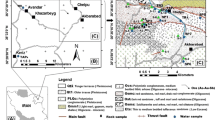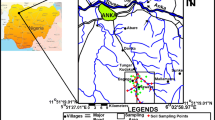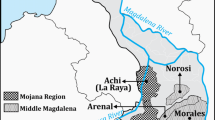Abstract
Following the appearance of symptoms of arsenic toxicity in the inhabitants of villages in the Muteh gold mining region, central Iran, the concentration of this element in various parts of biogeochemical cycle is investigated. For this purpose, rock, groundwater, soil, plant, livestock hair and wool, and human hair samples are collected and analysed. Total arsenic content ranges from 23 to 2,500 mg/kg in rock samples, 7–1,061 μg/l in water, 12–232 mg/kg in soil, 0.5–16 mg/kg in plant samples, 4.10–5.69 mg/kg in livestock hair and wool, and 0.64–5.82 mg/kg in human hair. Arsenic concentration in various parts of biogeochemical cycle near the gold deposit in a metamorphic complex, and also close to the gold-processing plant, is very high and decreases exponentially with increasing distance from them. Arsenic concentration in water from a well close to the Muteh gold mine is above 1 mg/L. Arsenic in hair samples taken from local inhabitants is above the recommended levels, and the control samples in Shahre-Kord city. Arsenic concentration is higher in male population and correlates positively with age. It is suggested that arsenic resulting from the decomposition of ore mineral such as orpiment (As2S3), realgar (As2S2) and arsenopyrite (FeAsS) is responsible for polluting natural resources and the human intake via drinking water and the food chain. Gold mining and processing has undoubtedly enhanced the release of arsenic and intensified the observed adverse effects in Muteh area.




Similar content being viewed by others
References
Abdollahi MJ, Karimpour MH, Kheradmand A (2009) Petrography and sulphur isotope studies of pyrites in the Muteh gold deposit. Am J App Sci 6:1086–1092
Acharyya SK, Lahiri S, Raymahashay BC, Bhowmik A (2000) Arsenic toxicity of groundwater in parts of the Bengal basin in India and Bangladesh: the role of quaternary stratigraphy and holocene sea-level fluctuation. Environ Geol 39:1127–1137
Afzal P, Aamdari S, Zakariai SJ, Lotfi M (2007) Arsenic distribution in Senjedeh ore deposit, Muteh mining complex. In: Proceeding of 7th Congress on Safety, Health and Environment in Mines and Related Industries, 30 October–1 November. Sarcheshmeh Copper Complex, Iran, pp 1–10 (in Farsi)
Agusa T, Kunito T, Fujihara J, Kubota R, Minh TB, Trang PTK et al (2006) Contamination by arsenic and other trace elements in tube-well water and its risk assessment to humans in Hanoi. Vietnam. Environ Pollut 139:95–106
Alavi M (1994) Tectonics of the Zagros orogenic belt of Iran: new data and interpretations. Tectonophys 229:211–238
Alavi M (2004) Regional stratigraphy of the zagros fold-thrust belt of Iran and its proforeland evolution. Am J Sci 304:1–20
Armienta MA, Segovia N (2008) Arsenic and fluoride in the groundwater of Mexico. Environ Geochem Health 30(4):345–353
Armienta MA, Rodriguez R, Cruz O (1997) Arsenic content in hair of people exposed to natural arsenic polluted groundwater at Zimp, Mexico. J Contam Toxicol 59:583–589
Berkowitz B, Dror I, Yaron B (2008) Contaminant geochemistry: interactions and transport in the subsurface environment. Springer, Heidelberg, p 412
Bhattacharya P, Welch AH, Stollewerk KG, McLaughlin MJ, Bundschuh J, Panaullah G (2007) Arsenic in the environment: biology and chemistry. Sci Total Environ 379:109–120
Bhumbla DK, Keefler RF (1994) Arsenic mobilization and bioavailability in soils. In: Niragu JO (ed) Arsenic in the environment, Part I, cycling and characterization. Wiley, New York, pp 51–82
Brady NC (1984) The Nature and properties of soils. MacMillan, New York
Burt R, Wilson MA, Keck TJ, Dougherty BD, Storm DE, Lindhal JA (2003) Trace element speciation in selected smelter-contaminated soils in Anaconda and Deer Lodge Valley, Montana, USA. Adv environ res 8:51–67
Chowdhury UK, Biswas BK, Chowdhury TR, Samanta G, Mandal BK, Basu GK, Chanda CR, Lodh D, Saha KC, Mukherjee SK, Roy S, Kabir S, Quamruzzaman Q, Chakraborti D (2000) Groundwater arsenic contamination in Bangladesh and West Bengal, India. Environ. Health Perspect 108(5):393–397
Dickson FW, Radtke AS, Weissberg BG, Heropoulos C (1975) Solid solutions of antimony, arsenic and gold in stibnite (Sb2S3), orpiment (As2S3) and realgar (As2S2). Econ Geol 70:591–594
Duker AA, Carranza EJ, Hale M (2005) Arsenic geochemistry and health. Environ Int 31:631–641
Eby GN (2004) Principles of environmental chemistry. In: Edmunds WM. Thomson, UK
Figueiredo BR, Borba RP, Angelica RS (2007) Arsenic occurrence in Brazile and human exposure. Environ Geochem Health 29:109–118
Georis B, Cardenas A, Buchet JP, Lauwerys RR (1990) Inorganic arsenic methylation by rat tissue slices. Toxicology 63:73–84
Herreweghe SV, Swennen R, Vandecasteele C, Cappuyns V (2003) Solid phase speciation of arsenic by sequential extraction in standard reference materials and industrially contaminated soil samples. Environ Pollut 122:323–342
Hinwood AL, Sim MR, Jolley D, Klerk ND, Bastone EB, Gerostamoulos J, Drummer OH (2003) Hair and toenail arsenic concentrations of residents living in areas with high environmental arsenic concentrations. J Environ Med 111:187–193
Hinwood AL, Sim MR, Jolley D, Klerk ND, Bastone EB, Gerostamoulos J, Drummer OH (2004) Exposure to inorganic arsenic in soil increases urinary inorganic arsenic concentration of residents living in old mining areas. Environ Geochem Health 26:27–36
Hughes MF (2002) Arsenic toxicity and potential mechanisms of action. Toxicol Lett 133(1):1–16
International Atomic Energy Agency (IAEA) (1978) IAEA/RL/50, Veina
Jones DC, Duvauchelle C, Ikegami A, Olsen CM, Lau SS (2005) Serotonergic neurotoxic metabolites of ecostasy identified in rat brain. J Pharmacol Exp 313:422–431
Kabata-Pendias A, Mukherjee AB (2007) Trace elements from soils to human. Springer-Verlag, Berlin
Karagas MR, Tosteson TD, Blum J, Klaue B, Weiss JE, Stannard V et al (2000) Measurement of low levels of arsenic exposure: a comparison of water and toenail concentrations. Am J Epidemiol 152:84–90
Keshavarzi B, Moore F, Esmaeieli A, Rastmanesh F (2009) The source of fluoride toxicity in Muteh area, Isfahan, Iran. Environ Earth Sci 61:777–786
Komatina MM (2004) Medical geology: effects of geological environments on human health. Elsevier Science and Technology, London
Kurttio P, Komulainen H, Hakala E, Kahelin H, Pekkanen J (1998) Urinary excretion of arsenic species after exposure to arsenic present in drinking water. Arch Environ Contam Toxicol 34:297–305
Liu B, Wu F, Li X, Fu Z, Deng Q, Mo C, Zhu J, Zhu Y, Liao H (2011) Arsenic, antimony and bismuth in human hair from potentially exposed individuals in the vicinity of antimony mines in Southwest China. Microchem J 97:20–24
Lu X, Zhang X (2005) Environmental geochemistry study of arsenic in Western Hunan mining area, P.R. China. Environ Geochem Health 27(4):313–320
Mandal BK, Ogra Y, Suzuki KT (2003) Speciation of arsenic in human nail and hair from arsenic-affected area by HPLC-inductively coupled argon plasma mass spectrometry. Toxicol Appl Pharmacol 189:73–83
Mason B, Moore CB (1982) Principles of Geochemistry, 4th edn. Wiley, New York
Materaa V, He’chob IL, Laboudiguea A, Thomasa P, Tellierb S, Astrucb M (2003) A methodological approach for the identification of arsenic bearing phases in polluted soils. Environ Pollut 126:51–64
Merian E, Anke M, Ihnat M, Stoeppler M (2004) Elements and their compounds in the environment. Willey, New York, p 350
Mianpiang Z (1997) An Introduction to Saline-alkaline Lakes on the Qinghai-Tibet Plateau. Kluwer, Dordrecht
Moritz R, Ghazban F (1996) Geological and fluid inclusion studies in the Muteh gold district, Sanandaj-Sirjan zone, Esfahan Province, Iran. Schweiz Miner Petrogr Mitt 76:85–89
Moritz R, Ghazban F, Singer BS (2006) Eocene gold ore formation at Muteh, Sanandaj-Sirjan tectonic zone, Western Iran: a result of late-stage extension and exhumation of metamorphic basement rocks within the Zagros Orogen. Econ Geol 101:1497–1524
Mosaferi M, Yunesian M, Dastgiri S, Mesdaghinia A, Esmailnasab N (2007) Prevalence of skin lesions and exposure to arsenic in drinking water in Iran. Sci Total Environ 390(1):69–76
Naidu R, Bhattacharya P (2009) Arsenic in the environment—risks and management strategies. Environ Geochem Health 1:1–8
Nvas-Acien A, Silbergergeld EK, Streeter RA, Clark JM, Burke TA, Guallar E (2006) Arsenic exposure and type 2 diabetes: a systematic review of the experimental and epidemiological evidence. Am J Epidemiol 162:1037–1049
Patel KS, Shrivas K, Brandt R, Jakubowski N, Corns W, Hoffmann P (2005) Arsenic contamination in water, soil, sediment and rice of central India. Environ Geochem Health 27(2):131–145
Rahman AA, Ravenscroft P (eds) (2003) Groundwater resources and development in Bangladesh – background to the arsenic crisis, agricultural potential and the environment. Bangladesh Centre for Advanced Studies. University Press Ltd., Dhaka
Ravenscroft P, Brammer H, Richards KS (2009) Arsenic pollution: a global synthesis. Wiley, Blackwell
Robb L (2005) Introduction to Ore-Forming Processes. Blackwell Publishing, Malden
Robles-Arenas VM, Rodrı’guez R, Garcı’a C, Manteca JI, Candela L (2006) Sulphide-mining impacts in the physical environment: Sierra de Cartagena-La Union (SE Spain) case study. Environ Geol 51:47–64
Ronov AB, Yaroshevski AA (1969) Earths Crust Geochemistry, Encyclopedia of Geochemistry and Environmental Sciences, Fairbridge RW (ed) Van Nostrand, New York, p 850
Schmitt MT, Schreinemachers D, Ning Z, Zhao B, Le XC et al (2005) Human nails as a biomarker of arsenic exposure from well water in inner Mongolia: comparing atomic fluorescence spectrometry and neutron activation analysis. Biomarkers 10:95–104
Schwedt G (2001) Essential guide to environmental chemistry. Willey, New York
Singh M, Singh AK, Swati, Srivastava N, Singh S, Chowdhary AK (2010) Arsenic mobility in fluvial environment of the Ganga Plain, northern India. Environ Earth Sci 59:1703–1715
Stocklin J (1968) Structural history and tectonics of Iran. a review. Am Assoc Petrol Geolog Bull 52:1229–1258
Stocklin J (1977) Structural correlation of the Alpine ranges between Iran and central Asia. Mem Hors-serie Soc Geol Fr 8:333–353
Sun G, Pi J, Li B, Guo X, Yamauchi H, Yoshida T (2001) Progress on researches of endemic arsenism in China: population at risk, intervention actions and related scientific issues. In: Chappell WR, Abernathy CO, Calderon RL (eds) Arsenic exposure and health effects IV. Elsevier, Oxford, pp 79–85
Tessier A, Campbell GC, Bisson M (1979) Sequential extraction procedure for the speciation of particulate trace metals. Anal Chem 51:844–851
Tseng CH, Tseng CP, Chiou HY, Hsueh YM, Chong CK, Chen CJ (2002) Epidemiologic evidence of diabetogenic effect of arsenic. Toxicol Lett 133:69–76
US EPA (2003) Arsenic treatment technology evaluation handbook for small systems. EPA 816-R-03-014, p 126
Vahter M, Marafante E (1983) Intracellular interaction and metabolic fate of arsenite and arsenate in mice and rabbits. Chem Biol Interact 47:29–44
Van Geen A, Ahmed KM, Seddique AA, Shamsudduha M (2003) Community wells to mitigate the current arsenic crisis in Bangladesh. Bull World Health Organ 82:632–638
Wang S, Mulligan CN (2006a) Occurrence of arsenic contamination in Canada: sources, behavior and distribution. Sci Total Environ 366(2–3):701–721
Wang S, Mulligan CN (2006b) Effect of natural organic matter on arsenic release from soils and sediments into groundwater. Environ Geochem Health 28:197–214
WHO (1999) Arsenic in Drinking Water, Geneva, p 210
WHO (2001) Environmental health criteria 224. arsenic and arsenic compounds, 2nd edn. World Health Organization, Geneva
Xia Y, Liu J (2004) An overview on chronic arsenism via drinking water in PR China. Toxicology 198(1–3):25–29
Yang L, Wng W, Hou W, Williams WP, Peterson PJ (2002) Arsenism clinical stages and their relation with hair arsenic concentration of residents of Bayimnaodo rural district, inner Mongolia, China. J Environ Geochem Health 24:337–348
Acknowledgments
The authors wish to express their gratitude to Mr. Lahijanzadeh of Esfahan environmental protection office for financially supporting this research. We would also like to extend our thanks to the members of the Research Committee of Shiraz University.
Author information
Authors and Affiliations
Corresponding author
Rights and permissions
About this article
Cite this article
Keshavarzi, B., Moore, F., Rastmanesh, F. et al. Arsenic in the Muteh gold mining district, Isfahan, Iran. Environ Earth Sci 67, 959–970 (2012). https://doi.org/10.1007/s12665-012-1532-3
Received:
Accepted:
Published:
Issue Date:
DOI: https://doi.org/10.1007/s12665-012-1532-3




